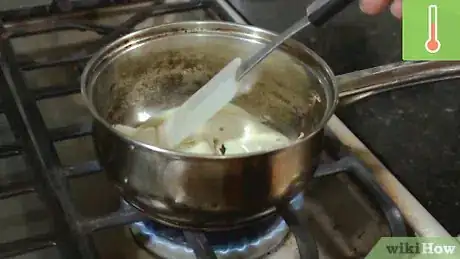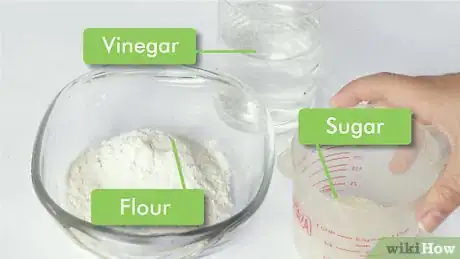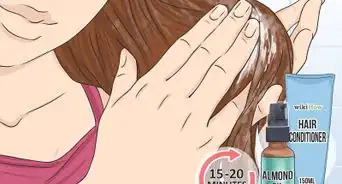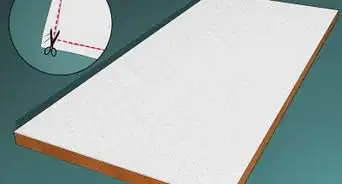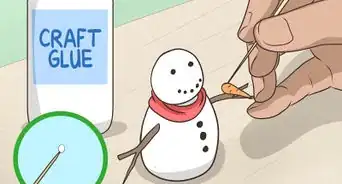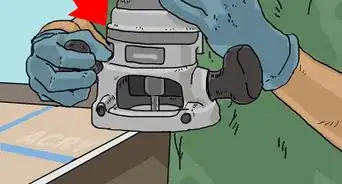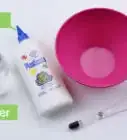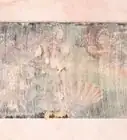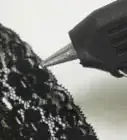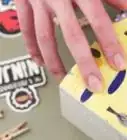wikiHow is a “wiki,” similar to Wikipedia, which means that many of our articles are co-written by multiple authors. To create this article, 176 people, some anonymous, worked to edit and improve it over time.
This article has been viewed 1,670,794 times.
Learn more...
Here are several different ways to make homemade glue. The simplest glue is made from a paste of flour and water. You can also make cornstarch paste or milk glue. All are easy, non-toxic, and great for making paper crafts including paper-mâché projects. Milk glue is stronger than a flour-based glue and is a fun glue to make because you can hear the chemical reactions happening while you make it! All of these glues are great for making with kids and require little time to complete.
Ingredients
- ½ cup flour
- ⅓ cup water
- 1 cup flour
- 1/3 cup sugar
- 1- 1 ½ cup water with 1 tsp white vinegar mixed in
- 1-1/2 cups cold water
- 2 tablespoons cornstarch
- 2 tablespoons corn syrup
- 1 teaspoon white vinegar
- 1 cup flour
- ½ cup water
- 1/8 teaspoon salt
- Baking soda
- ½ cup skim milk
- Measuring cup
- Rubber bands
- 2 tablespoons white vinegar
- Measuring spoons
- Paper towels
Steps
Making Simple Flour Glue
-
1Gather your ingredients. Use your measuring cup and measure ½ cup of flour and ⅓ cup water in a medium sized bowl. This simple flour glue is great to make if you are making crafts for a party or something short-term. This glue, however, will not usually last on long-term projects because it will dry out.
-
2Mix your flour and water in a bowl with a spoon. Blend the mixture until it as thick as pancake batter. The paste should not be too thick or too drippy.
- If you need more glue, simply double the recipe.
- If you need less glue, start with the amount of flour you will use, then add water, a teaspoon at a time, until it reaches the right consistency.
Advertisement -
3Cook the glue paste over medium heat until it boils. Pour your glue paste in a saucepan and stir constantly until the mixture bubbles. Take it off the heat when the paste starts bubbling, and wait until the mixture cools before you use it.
-
4Use the glue soon after making it. You can use a brush or your fingers to apply the glue to your crafts. The glue paste can be used to stick paper together for a variety of craft projects and decorations such as making greeting cards and kids projects.
- This glue can become moldy over time. To prevent mold, you should dry your craft project completely over a heater.
-
5Store in a refrigerator to reuse later. Keep any unused glue in a tightly-sealed container in the refrigerator. The glue should last a week or two.
- If the glue gets dry, add a little warm water to reuse it.
Making Paper Mache Glue
-
1Gather your ingredients. You will use flour, sugar, water and vinegar to make paper mache glue. You can adjust the recipe as needed to make more or less glue. The basic proportions are 3:1 for the flour:sugar mixture. Use one teaspoon of vinegar for every cup of flour you use.
- If you want a smoother paste, you can sift the flour before you make your paste.
-
2Mix one cup flour with ⅓ cup sugar. In a small saucepan, mix the flour and sugar with a spoon or whisk until well-blended.
-
3Add ¾ cup water and one teaspoon vinegar to the mixture. Blend the mix until it is very smooth and lump-free. It will have the consistency of a thick paste. When smooth, whisk in the rest of the water, ¼ cup to ¾ cup depending on how runny you want your paste, and mix thoroughly. Blend your ingredients until your glue is smooth and a little runny but not watery. Your paste should not be too thick or too drippy.
-
4Cook over medium heat. Pour your mixture in your saucepan and turn on the heat. Stir the mixture constantly until the mixture begins to thicken. Once your mixture starts to boil, you can turn off the heat.
-
5Let your glue cool before using it. When the mixture has cooled, use it for any craft projects including paper mache. Once you have finished, keep any unused glue in a tightly-sealed container in the refrigerator. This glue will keep for 2 to 4 weeks in the refrigerator.
-
6Glue something! When cooled, you can use this glue to make paper mache, craft projects, and anything else. It's totally non-toxic, too.
- Make sure to dry thoroughly any of the crafts you make with this glue. If the project stays damp, it may grow moldy over time. Mold needs water to grow so as long as you pat your products dry or heat them over an oven, you will keep mold away.
Making Cornstarch Glue
-
1Gather your ingredients. You will need cornstarch, corn syrup, vinegar and cold water. You will need a saucepan to heat the glue and a spoon to mix it with.
-
2Boil ¾ cup water, 1 teaspoon vinegar, and 2 tablespoons corn syrup. Mix ingredients together in a small saucepan. Turn the heat up to medium heat and bring the mixture to a full boil.
-
3Mix cornstarch paste. While the water is heating up, mix the remaining ¼ to ¾ cup water with 2 tablespoons cornstarch and blend thoroughly.
-
4Add the cornstarch paste to the boiling water. When the water is boiling, carefully mix in the cornstarch paste, stirring constantly until the mixture boils.
- Cook for a minute at a boil, then remove from heat. Don’t let the mixture boil to long or burn. Stir the mixture with a spoon constantly while it boils.
-
5Let it cool. When the mixture has cooled, pour into a sealable container, and store it in the refrigerator. This glue will keep for 2 to 4 weeks in the refrigerator.
- The glue may work better if you let it stand overnight before using.[1]
Making Simple No-Cook Flour Glue
-
1Gather your ingredients. Get together 1 cup flour, ½ cup water and ⅛ teaspoon salt.
-
2Blend together your ingredients in a small bowl. Pour in the flour, and add water, a bit at a time, to make a thick paste. Add a pinch of salt, and blend thoroughly. Your work is complete. You can use a brush to apply glue to your crafts.
Making Milk Glue
-
1Combine ½ cup skim milk with 2 tablespoons vinegar. Mix ingredients together well in a small bowl, and give the mixture 2 minutes to sit. The protein in the milk will clump together into small white lumps. And the chemical reaction will turn the protein of the milk into lumps or curds. The liquid that remains is called whey.
-
2Make a strainer to strain the curds from the whey. Put a paper towel over the top of a cup with a large mouth. Push down the paper towel in the middle so that it caves in. Then take your rubber band and put it around the top of the cup and paper towel to hold your paper towel strainer in place.[2]
- Choose a larger cup that you can pour the whole mixture of the curds and whey onto. Or pour the mixture onto the strainer, wait for it to strain and then pour on the rest.[3]
-
3Strain the curds from the whey. Carefully pour the curds and whey on top of the paper towel. The whey will drain into the cup while the curds will stay on the top of the paper towel.
- Leave the curds and whey on the paper towel strainer for about 5 minutes to give it time to strain.[4]
-
4Place the curds left on the top of the paper towel between two dry paper towels. Scoop the curds off of the top of the strainer and onto two paper towels. Press down on the curds so that all of the liquid whey is squeezed out. You want to make sure that you get out all of the whey to make the glue.[5]
-
5Combine the curds with 2 teaspoons of water and 1 teaspoon baking soda. In another small bowl, add the curds, water, and baking soda. Stir the mixture together well. You will be able to hear the sound of bubbles popping if you listen closely because the reaction of the baking soda with the curds creates carbon dioxide.
- If the mixture does not have the consistency of glue, add more water to the mixture by the teaspoon until it is the correct consistency.
-
6Finished.
Community Q&A
-
QuestionWhich kind of flour should I use to prepare glue?
 Community AnswerYou should use plain, white flour. Other types of flours usually contain other ingredients, which may interfere with the effectiveness of the glue.
Community AnswerYou should use plain, white flour. Other types of flours usually contain other ingredients, which may interfere with the effectiveness of the glue. -
QuestionCan I use the fourth glue example to make slime?
 Community AnswerNo because flour, water, and salt together would not make a substitute for the glue in slime.
Community AnswerNo because flour, water, and salt together would not make a substitute for the glue in slime. -
QuestionIf I make slime with the glue, will I have to throw it away faster than store-bought glue slime?
 KindnessCommunity AnswerYes, you are going to throw it away faster than store-bought glue slime. The slime you make with these types of glue contains water, which will make mold grow on the slime. If mold grows, you have to throw it away.
KindnessCommunity AnswerYes, you are going to throw it away faster than store-bought glue slime. The slime you make with these types of glue contains water, which will make mold grow on the slime. If mold grows, you have to throw it away.
Warnings
- Make sure to dry thoroughly anything stuck with flour and water paste. If it stays damp, it may go moldy. If it's moldy, you will have to waste it and start again!⧼thumbs_response⧽
Things You'll Need
- Ingredients listed for the recipe
- Bowl
- Saucepan
- Spoon
- Fork, whisk, or mixer
References
- ↑ http://www.canteach.ca/elementary/recipe7.html
- ↑ https://sciencing.com/chemicals-cornstarch-15444.html
- ↑ https://sciencing.com/chemicals-cornstarch-15444.html
- ↑ https://sciencing.com/chemicals-cornstarch-15444.html
- ↑ https://sciencing.com/chemicals-cornstarch-15444.html
- Videos provided by Life Hacktory
About This Article
To make glue, start by mixing 1/2 cup (70 grams) of flour and 1/3 cup (80 milliliters) of water in a bowl until the mixture has the consistency of pancake batter. Then, pour the mixture into a saucepan, and heat it over medium heat until it starts to boil. Finally, remove the glue from the heat, and let it cool before you use it.

